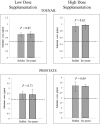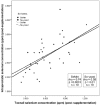Prostatic response to supranutritional selenium supplementation: comparison of the target tissue potency of selenomethionine vs. selenium-yeast on markers of prostatic homeostasis
- PMID: 23201838
- PMCID: PMC3509511
- DOI: 10.3390/nu4111650
Prostatic response to supranutritional selenium supplementation: comparison of the target tissue potency of selenomethionine vs. selenium-yeast on markers of prostatic homeostasis
Abstract
Prostate cancer is the product of dysregulated homeostasis within the aging prostate. Supplementation with selenium in the form of selenized yeast (Se-yeast) significantly reduced prostate cancer incidence in the Nutritional Prevention of Cancer Trial. Conversely, the Selenium and Vitamin E Cancer Prevention Trial (SELECT) showed no such cancer-protective advantage using selenomethionine (SeMet). The possibility that SeMet and Se-yeast are not equipotent in promoting homeostasis and cancer risk reduction in the aging prostate has not been adequately investigated; no direct comparison has ever been reported in man or animals. Here, we analyzed data on prostatic responses to SeMet or Se-yeast from a controlled feeding trial of 49 elderly beagle dogs-the only non-human species to frequently develop prostate cancer during aging-randomized to one of five groups: control; low-dose SeMet, low-dose Se-yeast (3 μg/kg); high-dose SeMet, high-dose Se-yeast (6 μg/kg). After seven months of supplementation, we found no significant selenium form-dependent differences in toenail or intraprostatic selenium concentration. Next, we determined whether SeMet or Se-yeast acts with different potency on six markers of prostatic homeostasis that likely contribute to prostate cancer risk reduction-intraprostatic dihydrotestosterone (DHT), testosterone (T), DHT:T, and epithelial cell DNA damage, proliferation, and apoptosis. By analyzing dogs supplemented with SeMet or Se-yeast that achieved equivalent intraprostatic selenium concentration after supplementation, we showed no significant differences in potency of either selenium form on any of the six parameters over three different ranges of target tissue selenium concentration. Our findings, which represent the first direct comparison of SeMet and Se-yeast on a suite of readouts in the aging prostate that reflect flux through multiple gene networks, do not further support the notion that the null results of SELECT are attributable to differences in prostatic consequences achievable through daily supplementation with SeMet, rather than Se-yeast.
Figures



Similar articles
-
Targeted Metabolomics Analysis Reveals that Dietary Supranutritional Selenium Regulates Sugar and Acylcarnitine Metabolism Homeostasis in Pig Liver.J Nutr. 2020 Apr 1;150(4):704-711. doi: 10.1093/jn/nxz317. J Nutr. 2020. PMID: 32060554
-
Selenium accumulation in prostate tissue during a randomized, controlled short-term trial of l-selenomethionine: a Southwest Oncology Group Study.Clin Cancer Res. 2006 Apr 1;12(7 Pt 1):2178-84. doi: 10.1158/1078-0432.CCR-05-0937. Clin Cancer Res. 2006. PMID: 16609032 Clinical Trial.
-
Application of isotope dilution analysis for the evaluation of extraction conditions in the determination of total selenium and selenomethionine in yeast-based nutritional supplements.J Agric Food Chem. 2006 Mar 8;54(5):1557-63. doi: 10.1021/jf0523768. J Agric Food Chem. 2006. PMID: 16506800
-
The nutritional significance, metabolism and toxicology of selenomethionine.Adv Food Nutr Res. 2003;47:73-112. doi: 10.1016/s1043-4526(03)47002-2. Adv Food Nutr Res. 2003. PMID: 14639782 Review.
-
Five threads: How U-shaped thinking weaves together dogs, men, selenium, and prostate cancer risk.Free Radic Biol Med. 2018 Nov 1;127:36-45. doi: 10.1016/j.freeradbiomed.2017.12.039. Epub 2018 Jan 2. Free Radic Biol Med. 2018. PMID: 29305107 Review.
Cited by
-
Selenium in pig nutrition and reproduction: boars and semen quality-a review.Asian-Australas J Anim Sci. 2015 May;28(5):730-46. doi: 10.5713/ajas.14.0593. Asian-Australas J Anim Sci. 2015. PMID: 25924964 Free PMC article.
-
Toward understanding success and failures in the use of selenium for cancer prevention.Antioxid Redox Signal. 2013 Jul 10;19(2):181-91. doi: 10.1089/ars.2013.5246. Epub 2013 Mar 21. Antioxid Redox Signal. 2013. PMID: 23421468 Free PMC article. Review.
-
Comparative effects of two different forms of selenium on oxidative stress biomarkers in healthy men: a randomized clinical trial.Cancer Prev Res (Phila). 2014 Aug;7(8):796-804. doi: 10.1158/1940-6207.CAPR-14-0042. Epub 2014 Jun 17. Cancer Prev Res (Phila). 2014. PMID: 24938534 Free PMC article. Clinical Trial.
-
Selenium and Dogs: A Systematic Review.Animals (Basel). 2021 Feb 6;11(2):418. doi: 10.3390/ani11020418. Animals (Basel). 2021. PMID: 33562028 Free PMC article. Review.
-
Selenium in Poultry Nutrition: from Sodium Selenite to Organic Selenium Sources.J Poult Sci. 2018;55(2):79-93. doi: 10.2141/jpsa.0170132. Epub 2017 Dec 25. J Poult Sci. 2018. PMID: 32055160 Free PMC article. Review.
References
-
- Clark L.C., Combs G.F., Jr., Turnbull B.W., Slate E.H., Chalker D.K., Chow J., Davis L.S., Glover R.A., Graham G.F., Gross E.G., et al. Effects of selenium supplementation for cancer prevention in patients with carcinoma of the skin. A randomized controlled trial. Nutritional Prevention of Cancer Study Group. JAMA. 1996;276:1957–1963. - PubMed
-
- Lippman S.M., Klein E.A., Goodman P.J., Lucia M.S., Thompson I.M., Ford L.G., Parnes H.L., Minasian L.M., Gaziano J.M., Hartline J.A., et al. Effect of selenium and vitamin E on risk of prostate cancer and other cancers: The Selenium and Vitamin E Cancer Prevention Trial (SELECT) JAMA. 2009;301:39–51. - PMC - PubMed
Publication types
MeSH terms
Substances
LinkOut - more resources
Full Text Sources

